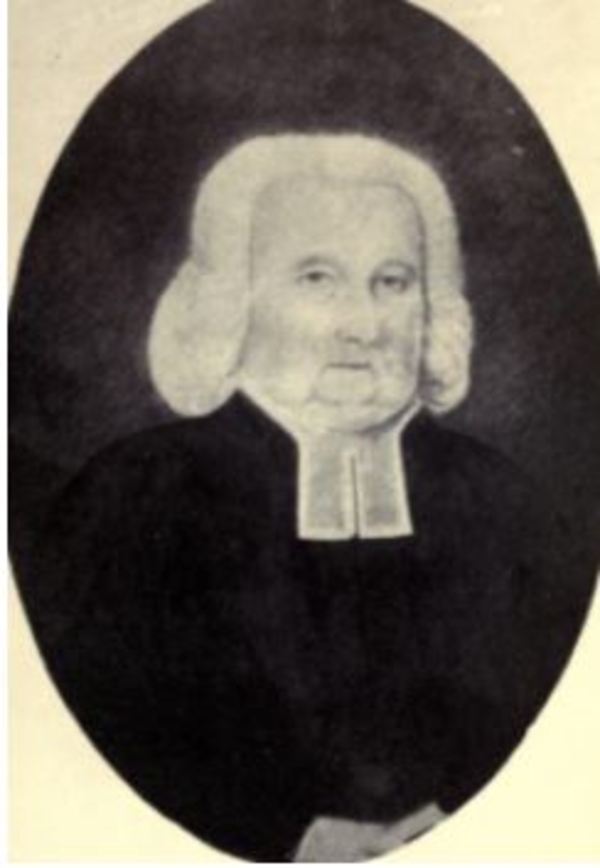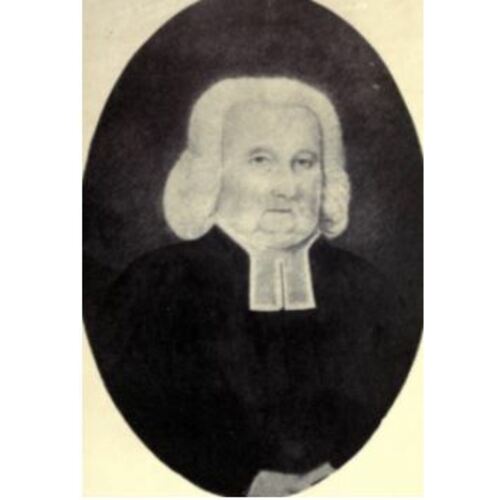
Source: Link
COMINGO (Comingoe), BRUIN ROMKES (he assumed the name Comingo after his arrival in Nova Scotia; also known as Mr Brown), fisherman and German Reformed minister; b. 21 Oct. 1723, probably in Groningen, Netherlands; m. first Ebjen (Eljen; perhaps also known as Fruche) – ; m. secondly 4 Sept. 1753 Rende Des Camps in Lunenburg, N.S.; m. there thirdly 1783 Catherine Margaret Bailly; d. there 6 Jan. 1820.
Bruin Romkes Comingo, a wool-comber, was living in the Dutch province of Groningen when he emigrated to Nova Scotia in May 1751. At that time he set sail for Halifax with his wife, Ebjen, and four children as part of a scheme whereby Britain hoped to populate the colony with “foreign Protestants” and thus offset the superior numbers of the Catholic French and their Indian allies. Unable to pay his family’s passage, Comingo, like most of his fellow emigrants, travelled as a government redemptioner. Upon arrival in Halifax he was obliged to labour for a time on the public works before being sent with the body of foreign Protestants in June 1753 to establish what is now the town of Lunenburg. Here he received a grant of land and became a fisherman; at some point in the 1760s he appears to have moved to Chester. But the life of an ordinary settler was not to be his fate, for in 1770 he was ordained a minister of the German Reformed Church.
Though the British government had made no allowance for the religious needs of the new settlers in Nova Scotia, there had been a non-Anglican congregation in Halifax from its beginning in 1749, composed mainly of Congregationalists from New England and Presbyterians from the north of Ireland. In Lunenburg, however, many years passed before the foreign Protestants were able to enjoy the services of their own churches. The Reverend Jean-Baptiste Moreau*, a former Roman Catholic priest, had arrived with the settlers in 1753 and had established the Anglican parish of St John in which he ministered to a flock representing a variety of Protestant denominations. Moreau clung to this task until he died in 1770, but by then the division of his congregation according to confession had already begun. In 1769, three years before the Lutheran settlers acquired a minister of their own from Germany, 60 German Reformed families left St John to establish a separate church. After failing to find a suitable minister either in Europe or in the colonies to the south, they chose from among themselves Bruin Romkes Comingo, a man lacking the liberal education and theological training usually required but respected for his piety and integrity.
The Presbyterian and Congregational churches shared a common confession with the German Reformed Church, and the bond among them enabled the local clergy to declare themselves an ad hoc presbytery, the first such body in Canada, for the purpose of carrying out the ordination. A great occasion was made of the ceremony, which was held on 3 July 1770 at Mather’s (St Matthew’s) Church in Halifax in the presence of Governor Lord William Campbell*, members of the Council, and representatives of other denominations. In a sermon the Reverend John Seccombe*, Congregational minister at Chester, argued that grace was to be preferred in a man to educational qualifications and that God had given Comingo the “Tongue of the learned.” The three other clergymen present – the Presbyterians James Murdoch (Horton) and James Lyon* (Onslow) and the Congregationalist Benajah Phelps (Cornwallis) – also took an active part in the proceedings: Murdoch, in justifying the ordination of a man who lacked formal theological training, quoted precedents from British churches in similar circumstances; Lyon presented the charge; and Phelps offered the “right hand of fellowship” with a short address.
Details of Comingo’s ministry are scant, but it is known that his congregation flourished and contributed in kind to the upkeep of their pastor. When he retired from full-time duties in 1818 – he was then 95 years of age – his Lunenburg flock acquired the services of a German-speaking minister from Europe, Johann Adam Moschell*.
Lunenburg County Registry of Deeds (Chester, N.S.) (mfm. at PANS). PANS, MG 1, 742, no.vi; MG 4, 91, 13 July 1783; 94; 96; MG 100, 125, no.14a (photocopy); Places, Lunenburg County, Winthrop Bell, Reg. of Lunenburg families, 171 (mfm.). PRO, CO 217/11: f.114; 217/14: ff. 117, 133. St Andrew’s Presbyterian Church (Lunenburg, N.S.), Dutch Reformed Church records, 1770–1870 (mfm. at PANS). St John’s Anglican Church (Lunenburg), Reg. of births and marriages, 1752–70, 4 Sept. [1753] fm. at PANS). St Paul’s Anglican Church (Halifax), Reg. of baptisms, marriages, and burials, 7 Nov. 1751, 4 Sept. 1753, 17 Aug. 1754 (mfm. at PANS). John Seccombe, A sermon preached at Halifax, July 3d, 1770, at the ordination of the Rev. Bruin Romcas Comingoe to the Dutch Calvanistic Presbyterian congregation at Lunenburg (Halifax, 1770). Acadian Recorder, 22 Jan. 1820. Bell, Foreign Protestants. M. B. DesBrisay, History of the county of Lunenburg (2nd ed., Toronto, 1895). I. F. Mackinnon, Settlements and churches in Nova Scotia, 1749–1776 ([Montreal, 1930]). W. C. Murray, “History of St. Matthew’s Church, Halifax, N.S.,” N.S. Hist. Soc., Coll., 16 (1912): 137–70. Juw fon Wearinga, “Ds. Brún Romkes (Camminga?), 1723–1820,” It Beaken (Assen, Netherlands), 19 (1957): 216–33; “The first Protestant ordination in Canada; the story of Brún Romkes Comingo, 1723–1820,” United Church of Canada, Committee on Arch., Bull. (Toronto), 11 (1958): 19–32.
Cite This Article
Ronald Rompkey, “COMINGO (Comingoe), BRUIN ROMKES (Mr Brown),” in Dictionary of Canadian Biography, vol. 5, University of Toronto/Université Laval, 2003–, accessed January 7, 2026, https://www.biographi.ca/en/bio/comingo_bruin_romkes_5E.html.
The citation above shows the format for footnotes and endnotes according to the Chicago manual of style (16th edition). Information to be used in other citation formats:
| Permalink: | https://www.biographi.ca/en/bio/comingo_bruin_romkes_5E.html |
| Author of Article: | Ronald Rompkey |
| Title of Article: | COMINGO (Comingoe), BRUIN ROMKES (Mr Brown) |
| Publication Name: | Dictionary of Canadian Biography, vol. 5 |
| Publisher: | University of Toronto/Université Laval |
| Year of publication: | 1983 |
| Year of revision: | 1983 |
| Access Date: | January 7, 2026 |



